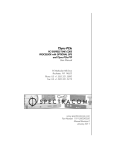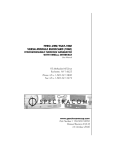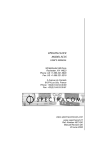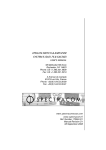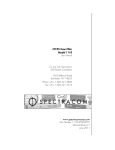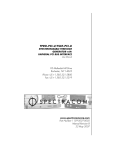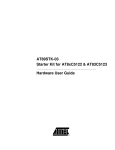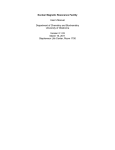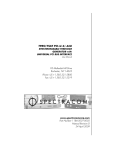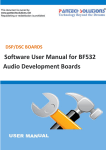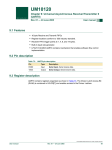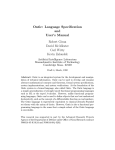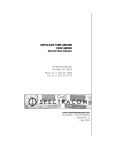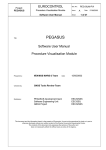Download TPRO-PC104 TSAT-PC104
Transcript
TPRO-PC104 TSAT-PC104 SYNCHRONIZABLE TIMECODE GENERATOR WITH ISA BUS INTERFACE User Manual 95 Methodist Hill Drive Rochester, NY 14623 Phone: 585.321.5800 Fax: 585.321.5219 www.spectracomcorp.com Part Number 1155-5001-0050 Manual Revision A (v2.0) June 2006 Copyright © 2006 Spectracom Corporation. The contents of this publication may not be reproduced in any form without the written permission of Spectracom Corporation. Printed in USA. Specifications subject to change or improvement without notice. Spectracom, NetClock, Ageless, TimeGuard, TimeBurst, TimeTap, LineTap, MultiTap, VersaTap, and Legally Traceable Time are Spectracom registered trademarks. All other products are identified by trademarks of their respective companies or organizations. All rights reserved. SPECTRACOM LIMITED WARRANTY LIMITED WARRANTY Spectracom warrants each new product manufactured and sold by it to be free from defects in software, material, workmanship, and construction, except for batteries, fuses, or other material normally consumed in operation that may be contained therein AND AS NOTED BELOW, for five years after shipment to the original purchaser (which period is referred to as the “warranty period”). This warranty shall not apply if the product is used contrary to the instructions in its manual or is otherwise subjected to misuse, abnormal operations, accident, lightning or transient surge, repairs or modifications not performed by Spectracom. The GPS receiver is warranted for one year from date of shipment and subject to the exceptions listed above. The power adaptor, if supplied, is warranted for one year from date of shipment and subject to the exceptions listed above. THE ANALOG CLOCKS ARE WARRANTED FOR ONE YEAR FROM DATE OF SHIPMENT AND SUBJECT TO THE EXCEPTIONS LISTED ABOVE. THE TIMECODE READER/GENERATORS ARE WARRANTED FOR ONE YEAR FROM DATE OF SHIPMENT AND SUBJECT TO THE EXCEPTIONS LISTED ABOVE. The Rubidium oscillator, if supplied, is warranted for two years from date of shipment and subject to the exceptions listed above. All other items and pieces of equipment not specified above, including the antenna unit, antenna surge suppressor and antenna pre-amplifier are warranted for 5 years, subject to the exceptions listed above. WARRANTY CLAIMS Spectracom’s obligation under this warranty is limited to in-factory service and repair, at Spectracom’s option, of the product or the component thereof, which is found to be defective. If in Spectracom’s judgment the defective condition in a Spectracom product is for a cause listed above for which Spectracom is not responsible, Spectracom will make the repairs or replacement of components and charge its then current price, which buyer agrees to pay. Spectracom shall not have any warranty obligations if the procedure for warranty claims is not followed. Users must notify Spectracom of the claim with full information as to the claimed defect. Spectracom products shall not be returned unless a return authorization number is issued by Spectracom. Spectracom products must be returned with the description of the claimed defect and identification of the individual to be contacted if additional information is needed. Spectracom products must be returned properly packed with transportation charges prepaid. Shipping expense: Expenses incurred for shipping Spectracom products to and from Spectracom (including international customs fees) shall be paid for by the customer, with the following exception. For customers located within the United States, any product repaired by Spectracom under a “warranty repair” will be shipped back to the customer at Spectracom’s expense unless special/faster delivery is requested by customer. Spectracom highly recommends that prior to returning equipment for service work, our technical support department be contacted to provide trouble shooting assistance while the equipment is still installed. If equipment is returned without first contacting the support department and “no problems are found” during the repair work, an evaluation fee may be charged. EXCEPT FOR THE LIMITED WARRANTY STATED ABOVE, SPECTRACOM DISCLAIMS ALL WARRANTIES OF ANY KIND WITH REGARD TO SPECTRACOM PRODUCTS OR OTHER MATERIALS PROVIDED BY SPECTRACOM, INCLUDING WITHOUT LIMITATION ANY IMPLIED WARRANTY OR MERCHANTABILITY OR FITNESS FOR A PARTICULAR PURPOSE. Spectracom shall have no liability or responsibility to the original customer or any other party with respect to any liability, loss, or damage caused directly or indirectly by any Spectracom product, material, or software sold or provided by Spectracom, replacement parts or units, or services provided, including but not limited to any interruption of service, excess charges resulting from malfunctions of hardware or software, loss of business or anticipatory profits resulting from the use or operation of the Spectracom product or software, whatsoever or howsoever caused. In no event shall Spectracom be liable for any direct, indirect, special or consequential damages whether the claims are grounded in contract, tort (including negligence), or strict liability. EXTENDED WARRANTY COVERAGE Extended warranties can be purchased for additional periods beyond the standard five-year warranty. Contact Spectracom no later than the last year of the standard five-year warranty for extended coverage. SPECTRACOM 95 Methodist Hill Drive Rochester, NY 14623 +1.585.321.5800 FAX: +1.585.321.5218 www.spectracomcorp.com [email protected] Spectracom Corporation TPRO-PC104/TSAT-PC104 Table of Contents 1 1.1 1.2 1.3 1.4 2 2.1 2.2 3 3.1 3.2 3.3 3.4 3.5 4 4.1 4.2 4.3 5 5.1 5.2 5.3 5.3.1 5.4 6 6.1 6.2 6.3 7 7.1 7.2 7.3 7.4 7.5 7.6 7.7 7.8 7.9 7.10 8 9 10 10.1 10.2 OVERVIEW .............................................................................................. 1-1 General Information about GPS ....................................................................................................1-1 Your Spectracom GPS Receiver ...................................................................................................1-2 Inventory........................................................................................................................................1-2 Inspection and Support..................................................................................................................1-3 SPECIFICATIONS..................................................................................... 2-1 TPRO-PC104 (Board Only) ...........................................................................................................2-1 TSAT-PC104 (GPS Receiver Only)...............................................................................................2-3 INPUT/OUTPUT PIN ASSIGNMENTS ...................................................... 3-1 Time Code Input BNC Connector (J1)...........................................................................................3-1 IRIG-B Output BNC Connector (J2)...............................................................................................3-1 Synchronized Reference Clock Output (JP1) ................................................................................3-1 P1 Connector Pinout (for TPRO-PC104 only) ...............................................................................3-1 P1 Connector Pinout (for TSAT-PC104 only) ................................................................................3-2 CONFIGURATION................................................................................... 4-1 I/O Base Address ..........................................................................................................................4-1 Interrupt Request Level .................................................................................................................4-1 External Event Time Tag Enable ...................................................................................................4-1 INSTALLATION ....................................................................................... 5-1 Before Installation..........................................................................................................................5-1 TSAT-PC104 only..........................................................................................................................5-2 Operation.......................................................................................................................................5-2 LED Status ....................................................................................................................................5-2 Propagation Delay Adjustment ......................................................................................................5-2 REGISTER ASSIGNMENTS ....................................................................... 6-1 Data Organization..........................................................................................................................6-2 16-bit Time Tagging.......................................................................................................................6-2 External Event Time Tagging ........................................................................................................6-3 INTERRUPTS ........................................................................................... 7-1 Introduction....................................................................................................................................7-1 Commands ....................................................................................................................................7-1 Setting Time ..................................................................................................................................7-3 Setting Propagation Delay Correction............................................................................................7-3 Disabling Synchronization to Input ................................................................................................7-4 Re-enabling Synchronization to Input............................................................................................7-4 Simulating Power-on Reset of TPRO-PC104 Firmware ................................................................7-4 Programming the MATCH (Start/Stop) Output For Pin 8 ...............................................................7-4 Programming the Heartbeat Output (Not Applicable to Option -HB1PPS)....................................7-5 Programming the Heartbeat Output (Option –H1PPS Only)..........................................................7-6 READING GPS LATITUDE AND LONGITUDE ........................................... 8-1 READING DILUTION OF PRECISION ...................................................... 9-1 PREVENTIVE MAINTENANCE ................................................................ 10-1 Oscillator Aging Adjustment.........................................................................................................10-1 IRIG-B Output Adjustment ...........................................................................................................10-1 Synchronizable Timecode Generator User Manual iii TPRO-PC104/TSAT-PC104 11 11.1.1 11.1.2 11.1.3 11.1.4 11.1.5 11.2 11.2.1 11.2.2 11.2.3 11.2.4 12 12.1 12.2 12.3 12.4 12.5 13 13.1 13.1.1 13.1.2 14 iv Spectracom Corporation OPTIONS AND ACCESSORIES............................................................... 11-1 -HB1PPS (Cannot Be Combined with Option -LOR1) .................................................................11-1 -LOR1 (Cannot Be Combined with Option -HB1PPS) .................................................................11-1 -M (Cannot Be Combined with Option -TTLLAY2 or Installed on TSAT-PC104) ........................11-1 -RECONN....................................................................................................................................11-2 -TTLLAY2 (Cannot Be Combined with Option M; Cannot Be Installed on TSAT-PC104; Compatible with IRIG-B ONLY) ......................................................................................................................11-2 Accessories .................................................................................................................................11-3 CAB-BO1 (Not Compatible with TSAT-PC104) ...........................................................................11-3 CAB-BO2 (TPRO-PC104 with Option -M Only; Not Compatible with TSAT-PC104) ..................11-3 TRIM-CAB-D-D-100 (TSAT-PC104 Only)....................................................................................11-3 TRIM-CAB-STD (TSAT-PC104 Only) ..........................................................................................11-3 TROUBLESHOOTING ............................................................................ 12-1 Bus Crashes ................................................................................................................................12-1 Bad Data from 16-bit Data Registers...........................................................................................12-1 Bad Data from FIFO Port.............................................................................................................12-1 Interrupt Crashes.........................................................................................................................12-2 Board Never Syncs to Input Code or 1PPS .................................................................................12-2 OPTIONAL PREVENTIVE MAINTENANCE .............................................. 13-1 Oscillator Aging Adjustment.........................................................................................................13-1 Necessary Equipment..................................................................................................................13-1 Procedure....................................................................................................................................13-1 DRIVER SUPPORT ................................................................................. 14-1 Synchronizable Timecode Generator User Manual Spectracom Corporation TPRO-PC104/TSAT-PC104 1 Overview This manual provides comprehensive information on the system architecture, specifications, and operation of the Spectracom TPRO-PC104 and TSAT-PC104 Synchronizable Time Code Generators. The TPRO-PC104 is a precision clock that automatically synchronizes to standardized time code signals (or, for the TSAT-PC104 configuration, to the GPS satellite system) and can be read from a host PC bus processor. It is used for time-tagging in 16-bit and 32-bit ISA bus systems. Time tagging can be caused by reading four 16-bit time registers or by a logic pulse from the outside world (an "external event"). Typically, the 16-bit reads are used for softwareinitiated time-tagging (for example, time-tagging the time a block of data transfer starts or completes). Reading the first 16-bit time register (for units of microseconds through units of milliseconds) also freezes the tens of milliseconds through hundreds of days. External events are usually used for time-tagging hardware-related events (for example, the exact time of a radar transmit pulse) because the added error of variation in software delays degrades the accuracy of a software initiated time tag. The time-tag data for external events is transferred to the host as a sequence of 10 bytes through a byte-wide hardware FIFO. Inputs to the TPRO PC104 are modulated timecode (or GPS receiver signals for TSAT-PC104), host commands (not usually needed), and external event pulses as required for the application. Outputs are modulated IRIG-B timecode and a "heartbeat" pulse rate that can be specified by the user program. The TPRO-PC104 can generate interrupts to the host system as enabled and selected by the host system. Interrupt sources include the heartbeat, external event data FIFO not empty, and start or stop time match. The clock automatically synchronizes to specified timecode signals. Status bits advise the host of synchronization status. If there is no synchronization source, the TPRO-PC104 starts counting at 000 days/00 seconds at power-on. The clock time can be set by operator commands. 1.1 General Information about GPS NOTE: GPS applies only to the TSAT-PC104 board; the TPRO-PC104 is not equipped for GPS. The United States government operates a set of approximately 32 satellites, collectively known as the "GPS Constellation" or "GPS Satellites." Each satellite has an internal atomic clock and transmits a signal specifying the time and satellite position. On the ground, the GPS receiver determines its position (longitude, latitude, and elevation) and the time by decoding the signals simultaneously from at least four of the GPS satellites. The satellite orbits are circular, inclined approximately 56 degrees from the equator, orbiting the Earth once every 11 hours. There are several different orbital planes, providing continuous coverage to all places on Earth. The GPS receiver uses an omni-directional antenna; the satellites move slowly across the sky (they are not at fixed locations). Synchronizable Timecode Generator User Manual 1-1 TPRO-PC104/TSAT-PC104 Spectracom Corporation Each satellite transmits a spread-spectrum signal, centered at 1575.42 MHz. When power is first applied, the GPS receiver begins searching for the satellites. It does this by searching for each satellite individually, listening for each satellite's distinct spread-spectrum hopping sequence. This process can take a few minutes, as the receiver iteratively locates satellites, refines its position, and determines for which satellites to search. The GPS receiver retains the last known position when the power is switched off. This results in faster satellite acquisition the next time it is switched on. If the antenna has been moved more than a few miles, however, acquisition time will be slightly longer because it must first recompute the position. 1.2 Your Spectracom GPS Receiver Your board’s GPS receiver is built into the antenna housing and communicates to the board via a serial (RS-422) interface. Power (+12V) is supplied from the board. The unit comes with a 100-foot cable. Extension cables are available in 100-foot lengths. The maximum total length is 500 feet. The connectors on the extension cables are not weatherproof; only the first 100-feet can be outdoors. The cable consists of several twisted pairs (not coaxial cable) and a foil shield. NOTE: Spectracom recommends applying an appropriate silicon grease to the cable connection at the GPS antenna in order to protect the connection from moisture. An additional weatherproofing kit (P/N 221213) containing butyl rubber and plastic tape is also available from Andrews Corporation, US 800.255.1479. 1.3 Inventory Before installing the board, please verify that all material ordered has been received. The TSATPC104 is delivered with a 100-foot cable with pre-installed connectors, a GPS receiver/antenna (housed together in a single enclosure), and a user manual. The TPRO-PC104 is delivered with mating connector (15-pin) and a user manual. If there is a discrepancy, please contact Spectracom Customer Service at US 585.321.5800. 1-2 Synchronizable Timecode Generator User Manual Spectracom Corporation 1.4 TPRO-PC104/TSAT-PC104 Inspection and Support Unpack the equipment and inspect it for damage. If any equipment has been damaged in transit, please contact Spectracom Customer Service at US 585.321.5800. If any problems occur during installation and configuration of your Spectracom product, please contact Spectracom Technical Support at US 585.321.5823 or US 585.321.5824. CAUTION: Electronic equipment is sensitive to Electrostatic Discharge (ESD). Observe all ESD precautions and safeguards when handling the timecode generator. NOTE: If equipment is returned to Spectracom, it must be shipped in its original packing material. Save all packaging material for this purpose. NOTE: In this manual, the prefix "0x" indicates that the number is in hexadecimal (Base 16) format. Synchronizable Timecode Generator User Manual 1-3 TPRO-PC104/TSAT-PC104 1-4 Spectracom Corporation Synchronizable Timecode Generator User Manual Spectracom Corporation TPRO-PC104/TSAT-PC104 2 Specifications 2.1 TPRO-PC104 (Board Only) Table 2.1—Time Code Input Specifications Code Format (autodetect) IRIG-A (A132), IRIG-B (B122), NASA36 Amplitude 1.2 Vp-p min, 8.0 Vp-p max Polarity Detected automatically Modulation Ratio 2:1 min, 3:1 typical, 4:1 max Input Impedance >10 K ohms Timing Accuracy Better than 100 ppm (not suitable for tape playback) Common Mode Voltage Differential input, ±100 V max Table 2.2—IRIG-B Output Specifications Code Format IRIG-B (B122) Amplitude (mark) 2.6 Vp-p (type) Modulation Ratio 3:1 Output Impedance 600 ohms Table 2.3—Time Tag Input Specifications Input Voltage –0.5V min, +0.8V max for logic 0 +2.0V min, +5.5 max for logic 1 Tags rising edge Input Current <5 μA for logic 0 <5 μA for logic 1 Rise/Fall Time 500 nS max Repetition Rate 1000 events per second max Timing Resolution 1 μS Table 2.4—1 PPS Sync Input Specifications (Option –M Only) Input Voltage 2.4 V min, 16.0 V max (high) (500 μA max at 5 Vin, 12 mA max at 16 Vin) Rise/Fall Time 500 nS max Trigger Edge Rising 1PPS Accuracy Must be 100 ppm or better Η One pulse-per-second Table 2.5—Match Output Specifications Output Voltage 3.8 V min at 32 mA (high) 0.4 V max at –64 mA (low) Setability 1 μS Synchronizable Timecode Generator User Manual 2-1 Spectracom Corporation TPRO-PC104/TSAT-PC104 Table 2.6—On-board Clock Specifications Resolution 1 μS Range 366:23:59:59.999999 Date Format Integer (001-366) Synchronization Time <8 seconds Stability Disciplined to timecode: +/- 2x10 –6 Undisciplined: +/- 1.5x10 –7 Table 2.7—General Specifications Size Typical PC104 Module Dimensions: 90.17 mm (3.550 in) X 95.89 mm (3.775 in) Power (from ISA bus) +5V ± 5% 425 mA max. +12V ± 5%: TPRO-PC104 225 mA max. TSAT-PC104 450 mA max. -12V ± 5% 50 mA max. Operating Temperature –0 to +70 C (–22 to +158 F) Storage Temperature –40 to +80 C (–40 to +176 F) Connectors BNCs for timecode input and output; DB15 (socket) for timecode input, output, heartbeat output, match output, time-tag input, 1 PPS input/output, and synchronized reference clock outputs. Table 2.8—TPRO-PC104 and TSAT-PC104 Indicators Card edge Diagnostic (Red LED) (AAR) Flashes short/long patterns for status Factory Test (Green, Red, Yellow LED) (AAR) Used during factory test. Table 2.9—Heartbeat Output Specifications Output Voltage 3.8 V min at 32 mA (high) 0.4 V max at –64 mA (low) Wave Shape Pulse or Square Wave (programmable) Pulse Width 150 nS min, 450 nS max Pulse Polarity Negative Square Wave 45% – 55% Timing Falling edge on-time (pulse or square wave) Range 1.000 μS–21.845 mS in 1 μS steps (1 MHz – 45.7771 Hz) Power-on default rate 100 PPS (pulse) Table 2.10—Synchronized Reference Clock Output Specifications (JP1) 2-2 Output Voltage 3.8 V min at 32 mA (high) 0.4 V max at –64 mA (low) Wave Shape Pulse or Square Wave (programmable) Pulse Width 150 nS min, 450 nS max Square Wave 45% – 55% Range 1 kHz, 1 MHz, 3 MHz, 5 MHz, 10 MHz Power-on default rate 10 MHz Synchronizable Timecode Generator User Manual TPRO-PC104/TSAT-PC104 2.2 Spectracom Corporation TSAT-PC104 (GPS Receiver Only) Table 2.11—GPS Receiver/Antenna Specifications Number of Satellites 6 Acquisition Time (cold start) 5 minutes typical, 15 min max Re-acquisition Time <1 minute Frequency 1575 MHz (receive only) (L1 band, C/A code {SPS}) Sync to UTC Within ±1.0 μS max (antenna in stationary position) Position 25 m SEP (w/o SA) (82 feet) Altitude 0 m to +18,000 m (0 to +59,055 feet) Size 147 mm Diam, 100 mm H (5.8” Diam, 3.9” H) Pole Mount 1.00” I.D., 14 tuns/inch straight (not tapered) Operating Temp –30 to +70 C (–22 to +158 F) Storage Temp –55 to +100 C (–67 to +212 F) Waterproof Submersion to 1 m Salt Fog MIL-STD-202F, Method 101D Condition B Synchronizable Timecode Generator User Manual 2-3 Spectracom Corporation 2-4 TPRO-PC104/TSAT-PC104 Synchronizable Timecode Generator User Manual Spectracom Corporation TPRO-PC104/TSAT-PC104 3 Input/Output Pin Assignments 3.1 Time Code Input BNC Connector (J1) The timecode input BNC connector is located nearest the 15-pin D-type connector. 3.2 IRIG-B Output BNC Connector (J2) The IRIG-B output BNC connector is located farthest from the 15-pin D-type connector. 3.3 Synchronized Reference Clock Output (JP1) Table 3.2—JP1 Header JP1 Pin User Connection 1-2 1 kHz (1000 PPS) 3-4 1 MHz 5-6 3 MHz 7-8 5 MHz 9-10 10 MHz 11-12 1 PPS Input Reference (-M Option only) The optional reference output clocks are user configurable via JP1 header adjacent to J1 BNC connector. Connection to reference clock outputs are obtainable via connector P1 pin 15. 3.4 P1 Connector Pinout (for TPRO-PC104 only) Table 3.1—P1 Connector P1 Pin User Connection 1 Timecode Input + (same as J1 BNC center) 2 Timecode Input – (same as J1 BNC shield) 3 Do Not Connect 4 Time Tag Input 5 Ground 6 Heartbeat Output 7 Ground 8 Match Output 9 10–13 1PPS Sync Input + (Option –FXI) / 1PPS Sync Output + (Option –FXO) Do Not Connect 14 1PPS Sync Input – (Option –FXI) / 1PPS Sync Output – (Option –FXO) 15 1PPS Sync Output TTL (Option –M only) / Synchronized Ref Clocks O/P The timecode input can be applied either to Pins 1 and 2 of P1 or to the J1 BNC connector (this is the connector closest to P1). The timecode input is a differential signal (i.e., timecode input is isolated from ground). It is acceptable to connect timecode input to ground. Synchronizable Timecode Generator User Manual 3-1 TPRO-PC104/TSAT-PC104 Spectracom Corporation The IRIG-B output can be taken either from Pin 9 of P1 or from the J2 BNC connector (this is the connector farthest from P1). The IRIG-B output is a single-ended signal (i.e., it is referenced to ground). 3.5 P1 Connector Pinout (for TSAT-PC104 only) The GPS receiver/antenna cable plugs into the 15-pin P1 connector. In addition, some pins may interface to the user’s equipment. It is the user’s responsibility to modify the antenna cable connector, if necessary, to access the “User Connection” pins. A description of the pinout for the supplied cable is shown in Table 3.2. Table 3.2—TSAT-PC104 P1 Connector Pinout P1 Pin Antenna Pin Antenna Connection Antenna Color User Connection 1 ––– ––– ––– Do not connect 2 ––– ––– ––– Do not connect 3 1 +12 Volts Red ––– 4 ––– ––– ––– Time Tag input 5 9 Ground Black Ground 6 ––– ––– ––– Heartbeat output 7 ––– Ground Shield ––– 8 ––– ––– ––– Match Time output 9 11 1PPS+ Orange/White ––– 10 5 RXD+ Yellow ––– 11 4 RXD– Brown ––– 12 3 TXD+ Orange ––– 13 2 TXD– Violet ––– 14 12 1PPS– Black/White ––– 15 ––– ––– ––– Do not connect The antenna cable wires are twisted pairs, as follows: Red with Black .......................................... (Pins 3 and 5) Orange with Violet................................. (Pins 12 and 13) Yellow with Brown................................. (Pins 10 and 11) Green with Blue ................................(Pins 15 and None) Orange/White with Black/White .............. (Pins 9 and 14) Note that the following antenna cable wires are connected at the antenna end, but not at J1: Antenna Pin Color 6 White 7 Gray 10 Blue The pigtail on the 15-pin end of the cable is used for custom options (if any). 3-2 Synchronizable Timecode Generator User Manual Spectracom Corporation TPRO-PC104/TSAT-PC104 4 Configuration 4.1 I/O Base Address Configured by Switch SW1 (8 bit DIP switch on bottom-side of assembly). The configurable address base bits are A11 through A4. SW1 maps address base bits A11 through A4 to SW1 bit 8 through SW1 bit 1. A switch in the ON (or closed) position selects logic ‘1’ (high) and when “open” or in the OFF position results in a logic ‘0’ (low) to that particular bit of base address. For example, the standard factory base address configuration is 0300H. This means that address bits 8 and 9 should be set to ‘1’ and address bits 11, 10, 7, 6, 5 and 4 should be set to ‘0’. So, the standard factory configuration has switch SW1 bits 8, 7, 4, 3, 2, and 1 set to the OFF (or logic ‘0’) position and switch SW1 bits 5 and 6 are set to the ON (logic ‘1’) position. 4.2 Interrupt Request Level Configured by switch SW2 (4 bit DIP switch on bottom-side assembly). User-selected interrupt request level can be configured via Table 4.1 below. The factory-configured level is IRQ10. Table 4.1—IRQ Selection - SW2 4.3 IRQ Bit 4 Bit 3 Bit 2 Bit 1 2 OFF OFF OFF OFF 3 OFF OFF OFF ON 4 OFF OFF ON OFF 5 OFF OFF ON ON 6 OFF ON OFF OFF 7 OFF ON OFF ON 10 OFF ON ON OFF 11 OFF ON ON ON 12 ON OFF OFF OFF 13 ON OFF OFF ON 14 ON OFF ON OFF External Event Time Tag Enable The operator can disable external events by jumpering JP6 Pin ‘2-3’ unless there is a source of external event pulses connected to P1 Pin 4. To enable external events jumper JP6 Pin 1–2. Synchronizable Timecode Generator User Manual 4-1 TPRO-PC104/TSAT-PC104 4-2 Spectracom Corporation Synchronizable Timecode Generator User Manual TPRO-PC104/TSAT-PC104 Spectracom Corporation 5 Installation 5.1 Before Installation Shut down the system, and install the TPRO-PC104 board in a 16-bit slot. The TPRO-PC104 has inputs and outputs that should be connected for the users requirements. There are up to three inputs from the external world: input timecode (if used), a TTL external event pulse (if used), and 1 PPS TTL time pulse (if used). Timecode input to the board is connected at J1 (center Pin or "+" side to Pin 1, shield or "–" side to Pin 2), or to BNC connector J2. For the TPRO-PC104, if input timecode or 1PPS input (Option –M) is not provided, the board will provide "local'' timing starting at 000 days, 00 hours, 00 minutes, 00 seconds. TTL external event pulses are connected at P1. The external event pulses can come from external user equipment, or pulse outputs from the TPRO-PC104 at P1 can be looped back and used as external event inputs with a simple jumper connection. If the 1 PPS option (Option –M) is to be used, P1 is used for 1PPS input. The 1PPS input can be RS-485 with +/A connected to P1 Pin 9 and -/B connected to P1 Pin 14. The 1PPS input can also be ground referenced (1PPS signal on P1 Pin 9, ground to P1 Pin 5 or Pin 7). The TSAT-PC104 is provided with a short adapter cable which mates with P1 at one end and with 3 antenna cable connectors at the other end. Connect all the TSAT-PC104 connectors. Custom factory configurations will have a manual addendum detailing non-standard I/O configuration. NOTE: Spectracom recommends applying an appropriate silcon grease to the cable connection at the GPS antenna in order to protect the connection from moisture. An additional weatherproofing kit (P/N 221213) containing butyl rubber and plastic tape is also available from Andrews Corporation, US 800.255.1479. NOTE: Before installing the TPRO-PC104 in your system, record the serial number, the PWB Revision Level (for example, “A1” or “A”), the firmware version labeled on EPROM U16 (for example, “99204223”), and the version labels on FPGA devices U12 (for example, “4302B Rev A.1”). This information will assist Spectracom in providing telephone support for your product(s). CAUTION: Observe all ESD procedures when handling the board and the computer. Before installing the board, discharge static buildup by touching the metal frame of the computer with one hand and the protective bag containing the board with the other hand. Open the protective bag only after static buildup has been safely discharged. Synchronizable Timecode Generator User Manual 5-1 TPRO-PC104/TSAT-PC104 5.2 Spectracom Corporation TSAT-PC104 only Install the combined antenna/GPS receiver unit at a location with 360° views to within 10° above the horizon. Attach the coaxial 1 PPS connector (TNC) and the 4-conductor serial connector to the antenna unit and route both 100-foot cables to the PC bus computer location. Start the system. 5.3 Operation The TPRO-PC104 (and TSAT-PC104) operates automatically as soon as the host computer system performs the power-on reset. To change the operating parameters or read data, consult Chapter Seven. 5.3.1 LED Status A card-edge LED (LED5) flashes a status pattern to assist in diagnosing installation errors. The pattern is a sequence of short and long flashes. Trailing short flashes are deleted so the status pattern can repeat more frequently. Table 5.1 details these patterns. Table 5.1—LED Flash Patterns Flash Position 5.4 Meaning of Short (cleared) Flash Meaning of Long (set) Flash 1 GPS satellite receiver being used for time reference Modulated timecode input being used for time reference 2 Synchronization to better than 5μsec verified with last 5 seconds Synchronization to better than 5μsec not verified within last 5 seconds 3 1PPS Pulse from GPS satellite receiver is OK 1 PPS pulse from GPS satellite receiver is bad. In applications with modulated timecode inputs only, this status bit will always be set. 4 GPS satellite receiver serial data being received OK No serial data being received from GPS satellite receiver. In applications with modulated timecode inputs only, this status bit will always be set. 5 GPS satellite receiver is tracking enough satellites for accurate UTC time. GPS satellite receiver is not tracking enough satellites for accurate UTC time. In applications with modulated timecode inputs only, this status bit will always be set. 6 Timecode input being decoded Timecode input not decodable. In applications without modulated timecode inputs, this status bit will always be set. 7 If using 1PPS, set NEXT 1PPS TIME command sequence has been performed. Used for Option –M only Waiting for “SET NEXT 1PPS TIME” command. Used for Option –M only Propagation Delay Adjustment Depending on the actual absolute time accuracy required in the user's application, the TPRO-PC104 can be commanded to correct for the time required for the timecode signal to travel the distance between the timecode source and the PC bus computer. This delay time, know as “propagation delay time”', is approximately 3.3 microseconds (μs) per kilometer for radio timecode transmission, and approximately 5 μs per kilometer for copper wire transmission. Also, a time delay on the order of 25 μs may be caused by small phase shifts due to reactances at the timecode input. To correct for propagation delay, the TPRO-PC104 can use a 5-2 Synchronizable Timecode Generator User Manual TPRO-PC104/TSAT-PC104 Spectracom Corporation propagation delay correction setting ranging between –1000 (because sometimes sources transmit early) and +8999 μs. The default setting is 0 μs after the TPRO-PC104 is reset at power-on, or after a RESET command from the operator. The operator can change the setting by a sequence of programmed commands to the command register on the TPRO-PC104. NOTE: If using the TSAT-PC104 with a valid GPS signal or 1PPS input (Option -M), propagation delay settings are neither needed nor used. If absolute microsecond accuracy is required, it is necessary to calibrate the TPRO-PC104 when it is installed; calibrate for propagation delay correction by comparing the on-board clock time with a portable reference (a 1 PPS GPS pulse is good for this). The appropriate propagation delay correction setting is converged on rapidly by trial and error. This setting does not need to be changed unless the location or cabling of the installation is changed. In most cases, determining the correct propagation delay setting needs the help of a special user program that lets the operator experiment with various propagation delay settings while zeroing in on the correct setting. The normal user program should be capable of using the correct setting once it is determined. Synchronizable Timecode Generator User Manual 5-3 TPRO-PC104/TSAT-PC104 5-4 Spectracom Corporation Synchronizable Timecode Generator User Manual TPRO-PC104/TSAT-PC104 Spectracom Corporation 6 Register Assignments Table 6.1—Register Assignments Offset from Base Address Bits 0 7–0 1 7 ——— 6 MATCH Flag Interrupt Enable MATCH Flag Interrupt Enable 5 HEARTBEAT Flag Interrupt Enable HEARTBEAT Flag Interrupt Enable ——— Read Usage Write Usage FIFO data n/u FIFO Output Ready Interrupt Enable FIFO Output Ready Interrupt Enable ——— 4 HEARTBEAT Flag 1=Clear flag 0=No change ——— 3 MATCH Flag 1=Clear flag 0=No change ——— 2 In-sync Flag ——— ——— 1 Time Code Input Decodable Flag ——— ——— 0 FIFO Empty Flag ——— 2 7–0 n/u Command Port 3 7–0 n/u Simulate external event (any data pattern) 4 7–0 n/u Reset FIFO and Release Microcomputer Reset n/u n/u n/u Assert Microcomputer Reset 5 6 7–0 8 15–0 (WORD) Time (Days) n/u A 15–0 (WORD) Time (hours and minutes) n/u C 15–0 (WORD) Time (seconds & 100s, 10s of milliseconds n/u E 15–0 (WORD) Time (10 μs–10 μs) n/u 3 Synchronizable Timecode Generator User Manual 0 6-1 TPRO-PC104/TSAT-PC104 6.1 Spectracom Corporation Data Organization Table 6.2—Data Organization (Base Address + Offset 8) Bits 15 12 Data 11 8 7 2 0 10 days BCD 4 3 10 dayBCD 0 1 dayBCD Table 6.3—16-bit Word Data Organization (Base Address + Offset A) Bits Data 15 12 10 hour 11 BCD 8 1 hour BCD 7 4 10 minute BCD 3 0 1 minute BCD Table 6.4— Data Organization (Base Address + Offset C) Bits Data 15 12 11 10 second BCD 8 7 4 3 10 μs BCD 0 10 μs BCD 5 1 second BCD 4 Table 6.5— Data Organization (Base Address + Offset E) Bits Data 6.2 15 12 11 10 μs BCD 3 8 10 μs BCD 2 7 4 10 μs BCD 1 3 0 10 μs BCD 0 16-bit Time Tagging To measure the instantaneous time, a program first performs a word I/O read from the loworder, 16-bit time register at Base Address + E. When the low-order register is read, the 3 highorder time words are stored concurrently in an internal register in the TPRO-PC104. They will be stored until the low-order time register is read again. So, whenever the high-order registers are read, the time that is returned is the time at which the low-order register was last read. 6-2 Synchronizable Timecode Generator User Manual TPRO-PC104/TSAT-PC104 6.3 Spectracom Corporation External Event Time Tagging When an external event logic pulse occurs, the TPRO-PC104 copies 10 bytes of time data into the on-board FIFO. It takes approximately 50 μs until the last of the 10 bytes is copied into the FIFO. The transfer time fluctuates because the microcomputer may be interrupted while putting data in the FIFO. The time data is accurate to the exact microsecond at which the event occurred, and the accuracy is not affected by the transfer time. The operator can simulate the occurrence of an external event pulse by doing a byte I/O write (any data value) to Base Address + 3. The host program reads captured time information (100s of days through units of μs…a total of 10 bytes) sequentially from the FIFO through the TPRO-PC104 bus interface. The host testing the FIFO EMPTY bit (Bit 0) performs handshaking of the TPRO-PC104 status register (base+1) for "1" before each byte is read from the FIFO output (base+0). It is important that the operator empty the FIFO of stale data when their program is initialized. This can be done by continuously reading the FIFO until the FIFO EMPTY status bit is "0'' for at least 100 μs. If the FIFO is full, this could take approximately 1024 reads. The data format for FIFO time stamps is: Table 6.6—FIFO Time Stamp Data Format Byte High Nibble Low Nibble 0 not defined not defined 1 not defined not defined 0 10 days 2 3 4 5 1 10 days 1 10 hours 2 0 10 days 0 10 hours 1 10 minutes 1 10 minutes 0 0 6 10 seconds 10 seconds 7 10 μseconds 10 μseconds 8 10 μseconds 10 μseconds 9 10 μseconds 10 μseconds 5 3 1 Synchronizable Timecode Generator User Manual 4 2 0 6-3 TPRO-PC104/TSAT-PC104 6-4 Spectracom Corporation Synchronizable Timecode Generator User Manual TPRO-PC104/TSAT-PC104 Spectracom Corporation 7 Interrupts 7.1 Introduction The TPRO-PC104 can be programmed to request interrupts at the IRQ level configured by P2 upon selectable conditions. Interrupts can be enabled by writing a "1" into the corresponding interrupt enable bit in Base Address+1. Table 7.1—Enabling Interrupts Interrupt Condition 7.2 Condition Asserted By User Action To De-assert Condition FIFO Not Empty External event or user command causes on board microprocessor to write data into FIFO I/O Read data from FIFO until FIFO empty or Write to Base +4 Match Flag Set User programmed START or STOP MATCH time is detected I/O Write to base +1 with bit 3 =1 Heartbeat Flag Set Periodic heartbeat pulse has occurred I/O Write to base+1 with bit 4=1 Commands Commands are sent to the TPRO-PC104 command register (Base Address+2) as a sequence of bytes. All commands should be spaced at least 100μs apart so the TPRO-PC104 firmware has sufficient time to handle each command. Without any commands, on cold or warm start the TPRO-PC104 will automatically synchronize to modulated timecode input or (for TSAT-PC) to a valid GPS receiver input. There are commands for: • • • • • • • • • • Setting time Setting propagation delay correction for modulated code input Disabling synchronization to input Re-enabling synchronization to input Simulating power-on reset of TPRO-PC104 firmware Reading TSAT-PC104 GPS antenna latitude Reading TSAT-PC104 GPS longitude Reading TSAT-PC104 GPS altitude Reading TSAT-PC104 GPS speed/course over ground # satellites visible, # satellites tracked Reading TSAT-PC104 GPS dilution of precision multipliers Synchronizable Timecode Generator User Manual 7-1 TPRO-PC104/TSAT-PC104 Spectracom Corporation Table 7.2—List of TPRO-PC104 Commands Command High Nibble Low Nibble SET PROPAGATION DELAY 10 μs 0 0–9 SET PROPAGATION DELAY 10 μs 1 0–9 SET PROPAGATION DELAY 10 μs 2 0–9 SET PROPAGATION DELAY 10 μs 3 0–9 SET NEXT 1PPS TIME 4 C ENABLE RESYNC 4 D DISABLE RESYNC 4 E 4 F 5 0–3 0 1 2 3 RESET TPRO-PC104 FIRMWARE 2 SET TIME SET REGISTER 10 DAYS REPORT DOPS 5 B REPORT COG/SATS 5 C REPORT ALTITUDE 5 D REPORT LONGITUDE 5 E REPORT LATITUDE 5 F 1 6 0–9 0 7 0–9 1 8 0–2 0 9 0–9 A 0–F B 0–F C 0–F SET TIME SET REGISTER 10 SECONDS 0 0 (10 seconds also used for 16 heartbeat counts) D 0–F COPY TIME SET REGISTER TO CLOCK TIME E 0 COPY TIME SET REGISTER TO START/STOP HOLD E 1 COPY START/STOP HOLD TO START MATCH REGISTER (DAYS, SECONDS) AND TIME SET REGISTER (HOURS, MINUTES, SECONDS) TO START μS E 2 COPY START/STOP HOLD TO STOP MATCH REGISTER (DAYS, SECONDS) AND TIME SET REGISTER (HOURS, MINUTES, SECONDS) TO STOP μS E 3 CLEAR MATCH FLAG E 4 COPY TIME SET REGISTER (MINUTES, SECONDS) TO HEARTBEAT DIVIDE PULSE GENERATE (no forced jam) E 5 COPY TIME SET REGISTER (MINUTES, SECONDS) TO HEARTBEAT DIVIDE PULSE GENERATE (with forced jam) E 6 COPY TIME SET REGISTER (MINUTES, SECONDS) TO HEARTBEAT DIVIDE SQUARE WAVE GENERATE (no forced jam) E 7 COPY TIME SET REGISTER (MINUTES, SECONDS) TO HEARTBEAT DIVIDE SQUARE WAVE GENERATE (with forced jam) E 8 REPORT FIRMWARE ID IN FIFO E 9 CLEAR SET TIME REGISTER F 0 SET TIME SET REGISTER 10 DAYS SET TIME SET REGISTER 10 DAYS SET TIME SET REGISTER 10 HOURS SET TIME SET REGISTER 10 HOURS 1 SET TIME SET REGISTER 10 MINUTES 1 3 (10 minutes also used for 16 heartbeat counts) 0 SET TIME SET REGISTER 10 MINUTES 0 2 (10 minutes also used for 16 heartbeat counts) 1 SET TIME SET REGISTER 10 SECONDS 1 1 (10 seconds also used for 16 heartbeat counts) 0 7-2 Synchronizable Timecode Generator User Manual TPRO-PC104/TSAT-PC104 7.3 Spectracom Corporation Setting Time The operator can set the TPRO-PC104 to use an input reference for applications where the input reference is not used. If the operator does not preset a time, a default preset of 0 days through seconds is used. The operator must disable input synchronization before setting time, or the TPRO-PC104 firmware will just switch back from the commanded time to the input time as soon as the input is validated. The sequence of commands for setting time is: Send CLEAR TIME SET REGISTER command (F0h) Send SET TIME SET REGISTER commands (5<bcd> through 8<BCD>) for 102 days through 100 seconds in any order Send COPY TIME SET REGISTER command (E0h) At least 100 μs should be allowed between sending each command byte. For example, to set time to 123 days 01 hours 23 minutes 45 seconds, send the sequence F0 51 62 73 80 91 A2 B3 C4 D5 E0. As each SET TIME SET REGISTER command is sent, the corresponding digit is set in an internal time set buffer in the TPRO-PC104. When the COPY TIME SET REGISTER command (E0) is received, the time set buffer is copied to the clock. 7.4 Setting Propagation Delay Correction The operator can set the compensation for propagation delay between the timecode source and the TPRO-PC104 location. On cold or warm start, the TPRO-PC104 assumes a propagation delay correction of 0 μs. The sequence of commands for setting propagation delay correction is: Send CLEAR TIME SET REGISTER command (F0h) Send SET TIME SET REGISTER commands (0<bcd> to 3<bcd>) for 10#μs, 10#μs, 10#μs, 10#μs, digits in any order Send SET COPY TIME SET REGISTER command (E0h) Remember to delay at least 100 μs between sending each command byte. For example, to set a propagation delay correction value of 1234 μs, send the sequence F0 31 22 13 04 E0. Some central timing facilities transmit time codes advanced by 1 millisecond. To correct for the advanced timecode, it may be desirable to use a negative propagation delay correction setting. Propagation delay settings of 9000μs to 9999μs are used to set NEGATIVE propagation delay correction values of –1000μs to –1μs, respectively. For example, to set –500 μs, use a setting of 9500 μs. So, the propagation delay correction range of the TPRO-PC104 is –1000 μs to +8999 μs. The TPRO-PC104 can distinguish between COPY TIME SET commands used for setting propagation delay and COPY TIME SET commands used for setting time by noting that different intervening commands have occurred after the CLEAR TIME SET REGISTER command. Synchronizable Timecode Generator User Manual 7-3 TPRO-PC104/TSAT-PC104 7.5 Spectracom Corporation Disabling Synchronization to Input To prevent the TPRO-PC104 from synchronizing its time to input signals, send the DISABLE RESYNC (4Eh) command to the TPRO-PC104. This command is normally used when the TPRO-PC104 time is set using the Set Generation Time procedure. 7.6 Re-enabling Synchronization to Input To release the TPRO-PC104 from a DISABLE RESYNC command, send the ENABLE RESYNC (4Dh) command to the TPRO-PC104. The cold or warm start condition for the TPROPC104 is resync enabled. 7.7 Simulating Power-on Reset of TPRO-PC104 Firmware The RESET (4Fh) command to the TPRO-PC104 resets the on-board Z80 microcomputer. 7.8 Programming the MATCH (Start/Stop) Output For Pin 8 This output goes high at the start time, and low at the stop time. The MATCH interrupt occurs at the start time. The MATCH flag goes true at the start time and remains true until the operator clears it with a software command. First, disable the Match interrupt by ANDing BF to Base+1. Put the days-seconds into the Time Set Register by writing to Base+2: F0 ; Clear time-set register 51 62 73 80 91 A2 B3 C4 D5 ; 123:01:23:45 day-second E1 ; Copy into Hold register Then, put 100s of mS through 1s of uS into the HH:MM:SS part of time register by writing to Base+2: 81 92 A3 B4 C5 D6 ; xx.123456 seconds This has specified a time of 123:01:23:45.123456 Write either E2 (load start time) or E3 (load stop time) to Base+2. (Note that the E2 or E3 command must be sent at least 250 mS before the commanded time occurs.) Enable Match interrupt (if desired) by ORing hex 40 to Base+1. The board can also be polled to determine if the start time has occurred. Read the value at Base+1, then AND this value with hex 08. If the result (MATCH flag) is non-zero (i.e., if bit 3 is set) the start time has occurred. It is necessary to clear this flag (by writing a one to bit 3 at Base+1) before the next start time can be detected. (Note that the actual value written must take into account the other bits in this register. The MATCH flag may be set during power-on reset. This is normal. 7-4 Synchronizable Timecode Generator User Manual TPRO-PC104/TSAT-PC104 7.9 Spectracom Corporation Programming the Heartbeat Output (Not Applicable to Option -HB1PPS) The heartbeat can be programmed to be either a pulse or a square wave. The specified rate must be an exact multiple of 1.000 uS. The range of programmable rates is: Minimum Rate (lowest frequency) .................................................. 21.845 mS (45.7771 Hz) Maximum Rate (highest frequency) .................................................... 1.000 uS (1.000 MHz) Pulse Width (time low, pulse mode only) ........................................ 150 nS min, 450 nS max To specify the rate (or frequency), compute the divide number N as follows. Note that N must be exactly divisible by 3, meaning that the specified period must be an exact multiple of 1.000 uS. To specify a period for a pulse or a square wave, compute N as follows: N = 3t / 10-6 .............................................................................. “t” is the period in seconds To specify a frequency for a pulse or square wave, compute N as follows: N = 3 * 106 / F.........................................................................“F” is the frequency in Hertz Not all values of N are acceptable. Verify that the computed value is evenly divisible by 3 and that it is in the range of 3 to 65,535, inclusive. Convert N into hexadecimal (base 16) notation. For example, if the desired output frequency is 10 kHz, N=300 (base 10), converted to hexadecimal notation yields N=012C (base 16). Send the hexadecimal number to the card by outputting the following sequence of bytes to the command register (base address +2). Note that the computed number appears in the least significant nibble of these bytes: A0 B1 C2 DC ; this loads 012C into the “heartbeat counts” register Finally, determine whether the output should begin using the new divide number immediately (“forced jam”) or at the end of the next period (“no forced jam”). Then send the appropriate byte to the command register, as follows: Pulse, starts at end of next period ..................................................................................E5 Pulse, starts immediately ................................................................................................E6 Square wave, starts at end of next period ......................................................................E7 Square wave, starts immediately ....................................................................................E8 To use the heartbeat to generate a periodic interrupt, first specify the frequency as described above (pulse or square wave), then enable the interrupt by ORing hex 20 to Base+1. To disable this interrupt, AND hex DF to Base+1 (Note that this operation may affect other bits in this register). Software can also poll the board to determine if a heartbeat has occurred. Read Base+1, then AND this value with hex 10. If the result is non-zero (i.e., if bit 4 is set) then a heartbeat has Synchronizable Timecode Generator User Manual 7-5 TPRO-PC104/TSAT-PC104 Spectracom Corporation occurred. It is necessary to reset this flag before detecting the next heartbeat. Reset the flag by writing hex 10 to Base+1 (Note that this operation may affect other bits in this register.). Example 1: Output a pulse once every 5 mS. Begin outputting immediately. First, compute N=(3 * (5*10-3) ) / (10-6) = 15000 (base 10). Next convert 15000 to hexadecimal. Thus, 15000 base 10 becomes 3A98 base 16. Finally, send the command sequence: A3 BA C9 D8 E6 to the command register at base address +2. Use the DOS Debug program to test the heartbeat output as follows: C:\> debug -o 302 a3 -o 302 ba -o 302 c9 -o 302 d8 -o 302 e6 -q ; ; ; ; ; ; 3 to divide register most significant nibble A to divide register 9 to divide register 8 to divide register least significant nibble command E6 for pulse with forced jam quits the Debug program Example 2: Output an 8 kHz square wave. Begin outputting at the end of the next heartbeat period. Compute N= ( 3*106 ) / ( 8*103) = 375 (base 10). Convert 375 to hexadecimal. Thus, 375 base 10 becomes 177 base 16. Send the command sequence A0 B1 C7 D7 E7 to the command register at base address + 2. Use the DOS Debug program to test the heartbeat output as follows: C:\> debug -o 302 a0 -o 302 b1 -o 302 c7 -o 302 d7 -o 302 e7 -q ; ; ; ; ; ; 0 to divide register most significant nibble 1 to divide register 7 to divide register 7 to divide register least significant nibble command E7 for square wave with no forced jam quits the Debug program The examples above assume that the board’s base address jumpers are set to 300 (default). The Debug program comes with DOS; it is not supplied by KSI. Debug commands consist of the letter “o”, space, I/O address, space, and the byte to be output. 7.10 Programming the Heartbeat Output (Option –H1PPS Only) The heartbeat output (P1 Pin 6) can be programmed to be either a pulse or a square wave. The specified rate must be an exact multiple of 1.000 mS. The range of programmable rates is: Minimum Rate (lowest frequency) ...................................... 65.534 Seconds (0.0152593 Hz) Maximum Rate (highest frequency) ................................................................. 2 mS (500 Hz) Pulse Width (time low, pulse mode only) ........................................................... 1 mS (typical) Programming Resolution .................................................................................................1 mS To specify the rate (or frequency), compute the divide number N as follows. To specify a period for a pulse or square wave, compute N as follows: 7-6 Synchronizable Timecode Generator User Manual TPRO-PC104/TSAT-PC104 Spectracom Corporation N = t / .001 ................................................................................ “t” is the period in seconds To specify a frequency for a pulse or square wave, compute N as follows: N = 1000 / F ............................................................................“F” is the frequency in Hertz Verify that the computed value is in the range of 2 to 65,534, inclusive. Convert N into hexadecimal (base 16) notation. For example, if the desired output period is once every 25 seconds, N=25,000 (base 10), converted to hexadecimal notation yields N= 0x61a8. Send the hexadecimal number to the board by outputting the following sequence to the command register. 0x00f0 0x00a6 0x00b1 0x00ca 0c00d8 ; Clear the Holding Register ; specifies N = 0x61a8 The heartbeat output can be programmed to be a square wave or a pulse, and can be programmed to begin immediately or at the beginning of the next cycle. Send one of the following commands to command port: 0x00e5 0x00e6 0x00e7 0x00e8 ; ; ; ; Pulse mode, starts at beginning of next cycle Pulse mode, starts immediately Square wave, starts at beginning of next cycle Square wave, starts immediately NOTE: The heartbeat output is present regardless of whether the board is in-sync or freewheeling. The power-on default is 1PPS, pulse mode. Synchronizable Timecode Generator User Manual 7-7 TPRO-PC104/TSAT-PC104 7-8 Spectracom Corporation Synchronizable Timecode Generator User Manual TPRO-PC104/TSAT-PC104 Spectracom Corporation 8 Reading GPS Latitude and Longitude The Report Latitude (5Fh) and Report Longitude (5Eh) commands cause the TPRO-PC104 to respond by putting 10 bytes of data in the on-board FIFO in the formats shown in the tables below. The data is valid only for TSAT–PC104 models tracking at least 4 satellites. Table 8.1—Latitude Command FIFO Data Response Byte High Nibble Low Nibble 0 Not defined Not defined 1 Not defined Not defined 2 not defined 10 degrees 3 10 degrees 4 10 minutes 5 10 minutes 2 1 10 degrees 0 1 10 minutes –1 10 minutes –3 0 –2 –4 6 10 minutes 10 minutes 7 Not defined Not defined 8 Not defined Not defined 9 Not defined Not defined Table 8.2—Longitude Command FIFO Data Response Byte High Nibble Low Nibble 0 Not defined Not defined 1 Not defined Not defined 2 Not defined 10 degrees 3 10 degrees 4 10 minutes 2 1 10 degrees 0 1 10 minutes –1 10 minutes –3 0 –2 5 10 minutes 6 10 minutes 10 minutes 7 Not defined Not defined 8 Not defined Not defined 9 Not defined Not defined Synchronizable Timecode Generator User Manual –4 8-1 TPRO-PC104/TSAT-PC104 Spectracom Corporation Reading TSAT–PC104 GPS antenna altitude, course over ground, and satellite tracking. The Report Altitude (5Dh) and Report COG/SATS (5Ch) commands cause the TPRO–PC104 to respond by putting 10 bytes of data in the on-board FIFO in the formats shown in the tables above. The altitude and COG data is valid only for TSAT–PC104 models that are tracking at least 4 satellites. Table 8.3— Altitude Command FIFO Data Response Byte High Nibble 0 5 1 5 2 10 day 3 10 meters D 1 10 day 6 10 meters 4 10 meters 2 10 meters 0 0 1 10 year 3 10 year 1 10 month 4 10 meters 5 10 meters 6 10 meters 7 Low Nibble D 0 5 3 1 o 10 year 8 10 year 9 10 month 2 0 Table 8.4—COG/SATS Command FIFO Data Response Byte 8-2 High Nibble Low Nibble 0 Not defined Not defined 1 Not defined Not defined 2 0 0 3 0 0 4 0 5 10 degrees COG 6 0 2 10 degrees COG 1 10 degrees COG 0 10 7 0 # SATS tracked 8 0 # SATS in view 9 Not defined Not defined –1 degrees COG Synchronizable Timecode Generator User Manual TPRO-PC104/TSAT-PC104 Spectracom Corporation 9 Reading Dilution of Precision The Report DOPS (5B) command causes the TPRO-PC104 to respond by putting 10 bytes of data in the on-board FIFO in the format shown in the table below. The data report tells the operator (for 3 orthogonal directions) how much the actual satellite constellation used for tracking degrades the theoretical-best GPS accuracy. DOPS data is valid only for TSAT-PC104 models that are tracking at least 4 satellites. Table 9.1— External 1 PPS Time Synchronization (Option –M) Byte High Nibble Low Nibble 0 Not defined Not defined 1 Not defined Not defined 1 10 EDOP multiplier -1 10 EDOP multiplier 1 10 NDOP multiplier –1 10 NDOP multiplier 1 10 VDOP multiplier –1 2 10 EDOP multiplier 3 10 EDOP multiplier 0 –2 0 4 10 NDOP multiplier 5 10 NDOP multiplier 6 10 VDOP multiplier 7 10 VDOP multiplier 10 VDOP multiplier 8 Not defined Not defined 9 Not defined Not defined –2 0 –2 Option –M provides a 1PPS synchronization input on Pin 9 and Pin 14 of the D-type connector. The 1PPS input can be RS-485 differential. The +/A signal connects to P1 Pin 9 and the -/B signal connects to P1 Pin 14. The 1PPS input can also be ground referenced (1PPS signal on P1 Pin 9, ground to P1 Pin 5 or Pin 7). A differential timecode input (IRIG-B, IRIG-A, NASA-36 or autodetect) can be applied to the BNC connector. If both 1PPS and timecode inputs are present, the board syncs to the incoming timecode and ignore the 1PPS. Note that Enable/Disable Resync commands 4D and 4E apply both to the 1PPS and the timecode input. Commands E0 and E9 are not supported. NOTE: The board expects the 1PPS input to be continuous. If the 1PPS signal stops pulsing after the board establishes initial sync, the board will continue to increment time ("freewheel"). However, if the 1PPS signal resumes after a period of freewheeling, the board may reset the time to 001:00:00:00.000000. This is due to the fact that the 1PPS occurs outside of the narrow window in which the board expects it, either because the 1PPS has moved or because the board's time has drifted during freewheeling. Specifications of the 1PPS input are: Input Voltage (high) ..........................................................................+2.4 V (min), +16.0 V (max) Input Current (high) .........................................500 uA (max) at +5.0 V, 12 mA (max) at +16.0 V Input Voltage (low)..............................................................................–0.2 V (min), +0.8 V (max) Input Current (low).................................................................................................. 500 uA (max) Rise/Fall Time.......................................................................................................... 500 nS (max) Synchronizable Timecode Generator User Manual 9-1 TPRO-PC104/TSAT-PC104 Spectracom Corporation Trigger Edge........................................................................................................................ Rising 1PPS Accuracy............ Must be better than 100 ppm (cannot be supplied from a tape playback) 9-2 Synchronizable Timecode Generator User Manual TPRO-PC104/TSAT-PC104 Spectracom Corporation 10 Preventive Maintenance 10.1 Oscillator Aging Adjustment The oscillator aging adjustment for the TPRO-PC104 corrects for the effects of aging on the natural crystal oscillator frequency to insure that the undisciplined frequency of the 10 MHz oscillator is 10.000000 MHz ±10 Hz. Preventive maintenance should be performed once every 2 years. The following items are required for testing: • A digital frequency counter with 0.1 PPM or better accuracy and 1 HZ or better resolution (be sure that the counter is calibrated) • A trimmer capacitor adjustment tool (non-metallic screwdriver) • If the unit is equipped with a custom crystal oscillator, consult the oscillator data sheet for adjustment method. Proceed as follows: • Disconnect J1 • Connect a calibrated frequency counter to the 1 MHz signal at J1 Pin 14. (Use Pin 5 or 7 for ground); or, connect to 10MHz-test point W4 and use W5 for ground. • Before powering up the system, disconnect the timecode input and/or the external 1PPS input to the board so that the oscillator will be undisciplined. • Power the system up and wait at least five minutes for the on-board crystal oven temperature to stabilize. Then adjust R22 for 1MHz ±1Hz (or 10MHz±10Hz if connected to W4). • Power down the system, and reconnect any disconnected inputs. 10.2 IRIG-B Output Adjustment IRIG-B output adjustment is seldom needed in the field. With the TPRO-PC104 at approximate operating temperature, adjust R46 ("FRQ") for zero crossover discontinuity at the transition from small to large amplitude cycles at the on-time position indicator. This adjustment ensures that the sine wave phase is in proper lock to the amplitude modulation signal. R48 ("SYM") adjusts sine waveform symmetry. Synchronizable Timecode Generator User Manual 10-1 TPRO-PC104/TSAT-PC104 10-2 Spectracom Corporation Synchronizable Timecode Generator User Manual TPRO-PC104/TSAT-PC104 Spectracom Corporation 11 Options and Accessories 11.1.1 -HB1PPS (Cannot Be Combined with Option -LOR1) The heartbeat output (P1 Pin 6) can be programmed as either a pulse or a square wave. The specified rate must be an exact multiple of 1.000 mS. The range of programmable rates is: Minimum Rate (lowest frequency)........................................... 65.534 Seconds (0.0152593 Hz) Maximum Rate (highest frequency) .....................................................................2 mS (500 Hz) Pulse Width (time low, pulse mode only) ............................................................. 1 mS (typical) Programming Resolution .....................................................................................................1 mS The default rate at power-up is 1Hz, pulse mode. Refer to Section 7.10 of this manual for detailed programming information. 11.1.2 -LOR1 (Cannot Be Combined with Option -HB1PPS) This option provides the board with three different signals on a three-pin header; a 1 Mega-Hertz Output (1MHZ), 1 Pulse Per Second Output (1PPS), and a Ground Output. The 3-pin header is located on U21 Pins 1, 2, and 3. The 3-pin header designations are: • • • JP4 Pin 11 is 1MHZ JP4 Pin 13 is 1PPS JP4 Pin 15 is Ground To set 1PPS, program the Heartbeat output for 1PPS. The 1PPS can be programmed for a rate between 0.0152593 HZ and 500 Hz. 11.1.3 -M (Cannot Be Combined with Option -TTLLAY2 or Installed on TSAT-PC104) Option –M provides a 1PPS synchronization input on Pin 9 and Pin 14 of the D-type connector. The 1PPS input can be RS-485 differential. The +/A signal connects to P1 Pin 9 and the -/B signal connects to P1 Pin 14. The 1PPS input can also be ground referenced (1PPS signal on P1 Pin 9, ground to P1 Pin 5 or Pin 7). A differential timecode input (IRIG-B, IRIG-A, NASA-36 or autodetect) can be applied to the BNC connector. If both 1PPS and Timecode inputs are present, the board syncs to the incoming timecode and ignores the 1PPS. Note that commands 4D and 4E (enable/disable sync) apply to both the 1PPS and the timecode input. Commands E0 and E9 are not supported. NOTE: The board expects the 1PPS input to be continuous. If the 1PPS signal stops pulsing after the board establishes initial sync, the board will continue to increment time (“freewheel”). However, if the 1PPS signal resumes after a period of freewheeling, the board may reset time to 001:00:00:00.000000. This is due to the fact that the 1PPS occurs outside of a narrow window in which the Synchronizable Timecode Generator User Manual 11-1 TPRO-PC104/TSAT-PC104 Spectracom Corporation board expects it, either because the 1PPS has moved or because the board’s time has drifted during freewheeling. Specifications of the 1PPS input are shown in Table 11.1. Table 11.1—1 PPS Input Specifications Input Voltage (high) +2.4 V (min), +16.0 V (max) Input Current (high) 500 μA (max) at –5.0 V, 12mA (max) at +16.0 V Input Voltage (low) –0.2 V (min), +0.8 V (max) Input Current (low) 500 μA (max) Rise/Fall Time 500 nS (max) Trigger Edge Rising 1PPS Accuracy Must be better than 100 ppm (cannot be supplied from a tape playback) 11.1.4 -RECONN This option provides reinforced connectors for the board. Both the BNC and the DB-15 connectors are glued to the board to ensure stability under stress conditions. 11.1.5 -TTLLAY2 (Cannot Be Combined with Option M; Cannot Be Installed on TSAT-PC104; Compatible with IRIG-B ONLY) This option reports decoded IRIG-B input Bits 50 through 98 in the FIFO in response to an operator command. It is used in cases in which the IRIG-B signal is being used for more than time of year. The operator causes the most recent complete set of bits to be written into the FIFO by writing a “5A” command to the Command port (base +2). The TPRO-PC104 firmware responds by writing the sequence of bytes found in Table 11.2. Table 11.2—Firmware Byte Sequence Byte 0 5A (hex) (command code echoed) 1 5A (hex) (command code echoed) 7 6 Bit 5 4 3 2 1 0 2 8 4 2 1 88 78 68 58 3 57 56 55 54 53 52 51 50 4 67 66 65 64 63 62 61 60 5 77 76 75 74 73 72 71 70 6 87 86 85 84 83 82 81 80 7 97 96 95 94 93 92 91 90 8, 9 not specified Where 2-digit numbers report to bit position in IRIG-B frame, and 8, 4, 2, 1 is the units of seconds for the IRIG-B frame containing reported data. Data is double-buffered so that all data 11-2 Synchronizable Timecode Generator User Manual TPRO-PC104/TSAT-PC104 Spectracom Corporation reported corresponds to reported second. Note that 99, 89, 79, 69, 59 are not reported, because they cannot be used for data bits. They are reserved for reference makers. 11.2 Accessories 11.2.1 CAB-BO1 (Not Compatible with TSAT-PC104) This cable provides multiple connections for a variety of inputs and outputs via the DB-15 connector on the board. Female BNC connectors are extended from the DB-15 connector in the following manner. Inputs Time Tag (external event) Pin # 4 Outputs Heartbeat Match Time 3MHz Pin# 6 8 14 11.2.2 CAB-BO2 (TPRO-PC104 with Option -M Only; Not Compatible with TSAT-PC104) This cable provides multiple connections for a variety of inputs and outputs via the DB-15 connector on the board. Female BNC connectors are extended from the DB-15 connector in the following manner. Inputs Time Tag (external event) 1PPS (Pulse Per Second) Pin # 4 15 Outputs HeartBeat Match Time 3 MHz Pin# 6 8 14 11.2.3 TRIM-CAB-D-D-100 (TSAT-PC104 Only) This cable acts as an extension cord for a board that is using the Trimble GPS Receiver. It consists of a 100’ cable with DB-15 connectors (one male, one female) on the ends. It connects to a board on one end, and to the standard TRIM-CAB-STD cable on the other end. It does not connect directly to the Trimble GPS Receiver. 11.2.4 TRIM-CAB-STD (TSAT-PC104 Only) This is the standard 100’ cable for the Trimble GPS Receiver. Synchronizable Timecode Generator User Manual 11-3 TPRO-PC104/TSAT-PC104 11-4 Spectracom Corporation Synchronizable Timecode Generator User Manual TPRO-PC104/TSAT-PC104 Spectracom Corporation 12 Troubleshooting 12.1 Bus Crashes If, when trying to access the TPRO-PC104, the program crashes due to a bus error, the problem may be that the board address configured in P3 does not agree with the program being used. 12.2 Bad Data from 16-bit Data Registers If the program does not crash, but starts to get peculiar data from the 16-bit registers (“illegal BCD”, etc.), the problem could be: • Using an address that maps into a different PC bus device. • Using a base address that maps into both the TPRO-PC104 and another PC bus device. • Accessing high-order bits at base +A, +C or +E before freezing/reading low-order bits at base+8. • Reading data (especially if there are numerous zeros) before the TPRO-PC104 has synchronized to the input code. • Remember that there is an approximate 20-second delay from power-on until the TPRO-PC104 jam syncs to the input code. • Performing a TIME SET command sequence with unusual values. 12.3 Bad Data from FIFO Port If the program does not crash, but has incorrect data from the FIFO, the problem could be: • The code does not check the “FIFO NOT EMPTY” bit in the STATUS REGISTER for "1" before reading each byte from the FIFO. If the data contains "00" or seems to slip (e.g., hours show up where minutes are expected) this is very likely the reason. • Reading data (especially if there are numerous zeros) before the TPRO-PC104 has synchronized to the input code. NOTE: Remember that there is an approximate 20-second delay from power-on until the TPRO-PC104 jam syncs to the input code. A longer delay of up to one minute occurs for a TSAT-PC104 doing a start with an up-to-date satellite almanac. A very long delay of up to 45 minutes occurs for a TSAT-PC104 doing a start with invalid (over 2 weeks old) almanac data or an initial position that is grossly (e.g., over 1000 km) in error. • Performing a TIME SET command sequence with incorrect values. • Using an address that maps into memory or into a different device. Synchronizable Timecode Generator User Manual 12-1 TPRO-PC104/TSAT-PC104 12.4 Spectracom Corporation Interrupt Crashes Ascertain that the host interrupt vector/level is correctly initialized. When using the “FIFO NOT EMPTY” interrupt selection, disable the interrupt and enable it either at the TPRO-PC104 or at the host interrupt controller while reading the FIFO, otherwise it could cause nested FIFO NOT EMPTY interrupts as each byte is read from the FIFO and the IRQ line may toggle. 12.5 Board Never Syncs to Input Code or 1PPS Loss of sync should be asserted in many cases. If the “loss of sync” status bit is “0” (which indicates an error), its assertion does not mean that there is a fault in the board. NOTE: Remember that there is an approximate 20-second delay from power-on until the TPRO-PC104 jam syncs to the input code. A longer delay of up to one minute occurs for a TSAT-PC104 doing a start with an up-to-date satellite almanac. A very long delay of up to 45 minutes occurs for a TSAT-PC104 doing a start with invalid (over 2 weeks old) almanac data or an initial position that is grossly (e.g., over 1000 km) in error. If the status LED does not indicate a decodable input signal, then the TPRO-PC104 does not see a signal that it can decode. Check the signal amplitude and connections. Both the “+” (signal) and “–” side of the input code should be connected. Remember that the input is differential for common mode noise rejection. As a last resort, examine the input signal on an oscilloscope and make sure that it meets the input specifications of the TPRO-PC104. When using 1PPS, make sure that it is a good 1PPS. Has a SET NEXT 1PPS TIME command sequence been performed? Is the timecode carrier frequency stable to ±100 PPM? Does it make periodic large (larger than 5 μsecond) time jumps? Tape playback is very likely to have high-frequency error, unless a calibrated servo track is used for accurate speed control. 12-2 Synchronizable Timecode Generator User Manual TPRO-PC104/TSAT-PC104 Spectracom Corporation 13 Optional Preventive Maintenance 13.1 Oscillator Aging Adjustment The oscillator aging adjustment for the TPRO/TSAT-PC104 corrects for the effects of aging on the natural crystal oscillator frequency to insure that the undisciplined frequency of the 10 MHz oscillator is 10.000000 MHz ±10 Hz. Although optional, it is strongly recommended that this preventive maintenance be performed once every two years. 13.1.1 Necessary Equipment • A digital frequency counter with 1 PPM or better accuracy and 1 Hz or better resolution (be sure that the counter is calibrated). • A trimmer capacitor adjustment tool (non-metallic screwdriver). If you have a custom crystal oscillator in your unit, consult the oscillator data sheet for adjustment method. CAUTION: Electronic equipment is sensitive to Electrostatic Discharge (ESD). Observe all ESD precautions and safeguards prior to calibration. 13.1.2 Procedure 1. Power down the system. 2. Connect a calibrated frequency counter to the 1 MHz signal at JP9 Pin 4. (Use JP10 Pin 3 for ground.) 3. Before powering up the system, disconnect the timecode input and/or the external 1PPS input to the board so that the oscillator is undisciplined. 4. Power the system up and wait at least five minutes for the on-board crystal oven temperature to stabilize. Then adjust the oscillator’s on-board trimmer for 1MHz ±1Hz. 5. Power down the system, and reconnect any disconnected inputs. Synchronizable Timecode Generator User Manual 13-1 TPRO-PC104/TSAT-PC104 13-2 Spectracom Corporation Synchronizable Timecode Generator User Manual TPRO-PC104/TSAT-PC104 Spectracom Corporation 14 Driver Support Please contact your sales representative for information about Spectracom’s bus-level timing board driver support for Windows, Linux, VxWorks, and a variety of other platforms. You may also visit our website at www.spectracomcorp.com to download datasheets and manuals. Synchronizable Timecode Generator User Manual 14-1 TPRO-PC104/TSAT-PC104 14-2 Spectracom Corporation Synchronizable Timecode Generator User Manual Spectracom Corporation 95 Methodist Hill Drive Rochester, NY 14623 www.spectracomcorp.com Phone: 585.321.5800 Fax: 585.321.5219




















































